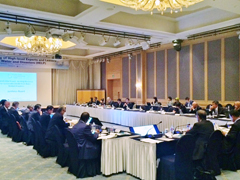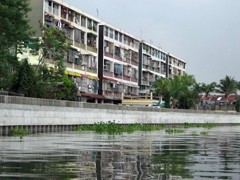Chief Economist Koki Hirota Presents Flood Control Infrastructure Demand Estimate at HELP Meeting in South Korea
2017.10.13
On September 21, 2017, the 10th Meeting of High-level Experts and Leaders Panel on Water and Disasters (HELP) was held in Gyeongju, South Korea. Koki Hirota, the Chief Economist of JICA, and Mikio Ishiwatari, senior advisor on Disaster Management and Water Resource Management, who are both involved in the "Research on Demand Estimate on Infrastructure in Asia" research project currently underway at the JICA Research Institute (JICA-RI), participated in the meeting.
HELP was established in 2014 under the direction of the UN Secretary General's Advisory Board on Water and Sanitation (UNSGAB) to strengthen preventative measures for disasters in order to mitigate the damage from water-related disasters which have become more frequent and severe around the world. HELP reviews and deliberates on the efforts of the international community and individual organizations needed to increase investment in water-related disaster management and bolster the science and engineering it requires.

About 50 panel members participated in the 10th meeting of HELP
Under the title "Estimating Demand for Flood Control Infrastructure," Hirota presented an analysis of flood control investment in Europe, the United States and Japan, and the findings of research on the demand estimate in Japan and the Philippines. He pointed out that, although investment in flood countermeasures and other disaster prevention is not necessarily low compared to in roads, ports and other parts of the economic infrastructure, research on forecasting demand has been insufficient. This may have been caused by the large differences in disaster risk between countries due to climate, geological and topographical conditions, and the difficulty of standardizing the target settings for disaster prevention.
Accordingly, Hirota presented the demand estimate exercise that JICA has been working on recently using past flood control budgets and socio-economic indicators, rather than those calculated from stock data. Japan's experience shows that an increased flood control measures budget leads to a significant drop in damage, as well as an estimate of the demand from now until 2030. He also explained that the Philippines is rapidly increasing investment in flood control, with the percentage of GDP expected to increase from the current 0.45% to over 1% by 2030. In conclusion, Hirota proposed collecting information on disaster prevention budgets in other flood-prone countries in Asia, to create a common model for the entire region, and to estimate the demand in developing countries throughout Asia.
Following the presentation, participants discussed the possibility of increasing investment before a major disaster occurs, rather than after. One participant pointed out that the interest of policymakers and the general populace wanes quickly after a disaster, so the decision to increase investment needs to be done promptly. Other comments included the need for an insurance system for individual-level recovery that the national government cannot cover and the need for further contributions of science and technologies for damage mitigation.

Japan supported rehabilitation of the Pasig River bank in order to reduce the risk of flood damage in Manila, the Philippines
The JICA research project garnered significant interest from participants, and they asked for continued sharing of results. From a global perspective, this is a field where research activities are not very active. It is still unclear how much flood control investment is currently being made worldwide and how it is increasing. The research will continue in collaboration with related organizations, and the results will be shared in accordance with the progress made.

事業事前評価表(地球規模課題対応国際科学技術協力(SATREPS)).国際協力機構 地球環境部 . 防災第一チーム. 1.案件名.国 名: フィリピン共和国.

事業事前評価表(地球規模課題対応国際科学技術協力(SATREPS)).国際協力機構 地球環境部 . 防災第一チーム. 1.案件名.国 名: フィリピン共和国.

事業事前評価表(地球規模課題対応国際科学技術協力(SATREPS)).国際協力機構 地球環境部 . 防災第一チーム. 1.案件名.国 名: フィリピン共和国.

事業事前評価表(地球規模課題対応国際科学技術協力(SATREPS)).国際協力機構 地球環境部 . 防災第一チーム. 1.案件名.国 名: フィリピン共和国.

事業事前評価表(地球規模課題対応国際科学技術協力(SATREPS)).国際協力機構 地球環境部 . 防災第一チーム. 1.案件名.国 名: フィリピン共和国.
scroll